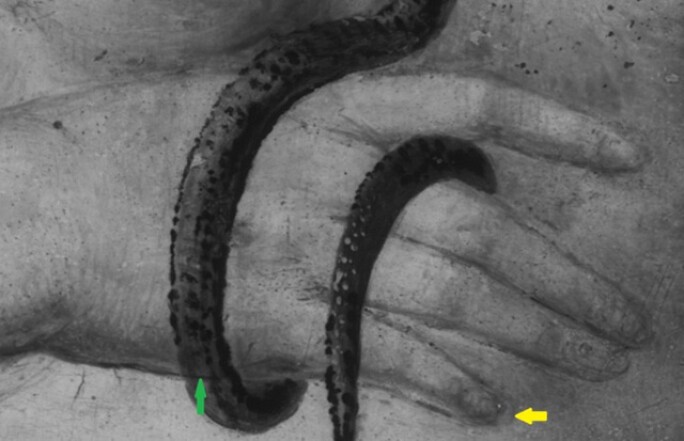Understanding how to read this imagery is key to making the most out of the scientific technological results. Let’s look at Cleopatra by Michele Tosini, called Michele di Ridolfo, coming up in our Old Masters Evening Sale on 4 July, as an example of how we might better understand the medium, technique and changes in design that are all made visible by infrared reflectography.
Medium
The first thing that we can tell from this infrared image is what was used to create the drawing. In this case we can see from the variation in width and tapering of the strokes that it is a liquid medium (probably an ink) applied with a brush. This was quite usual for underdrawings by Florentine artists of this period.
An underdrawing like this appears as quite a pale line in infrared images because of its low carbon content. A drawing made using a substance such as graphite, or charcoal has a much higher level of carbon and so appears much darker, because it absorbs more of the infrared radiation.

Technique
Tosini executed an extensive freehand underdrawing to map out Cleopatra’s form, and then used parallel hatching strokes to model the contours of her flesh and folds in the drapery.
This image shows both techniques – the single outline of her hand (yellow arrows), as well as the close hatching to create the shadows of the drapery around her wrist (red markings ).
Changes of heart
Differences between the underdrawing and the painted surface are evidence of the artist’s thought process at varying stages of the execution. These changes show us that the artist allowed himself (or herself) freedom to deviate from the original drawing when they were actually applying the paint.
If the underdrawing and design of a finished painting correspond exactly, this is often an indication that an assistant may have been responsible for finishing the work, simply following the design of his master without independent thought.
There are several small differences between the drawing and painting stages in this picture - evidence that Tosini himself created Cleopatra from the initial design to the final brushstroke.
Over the many hundreds of years since Tosini painted Cleopatra, the paint used in her flesh tones have become more transparent than the artist would have intended them to be, meaning that much of what we see in the infrared images is actually visible to the naked eye.
This makes Cleopatra the perfect picture on which to practise reading an infrared report. Come and find us in the galleries at Sotheby’s New Bond Street so we can show you in person!







